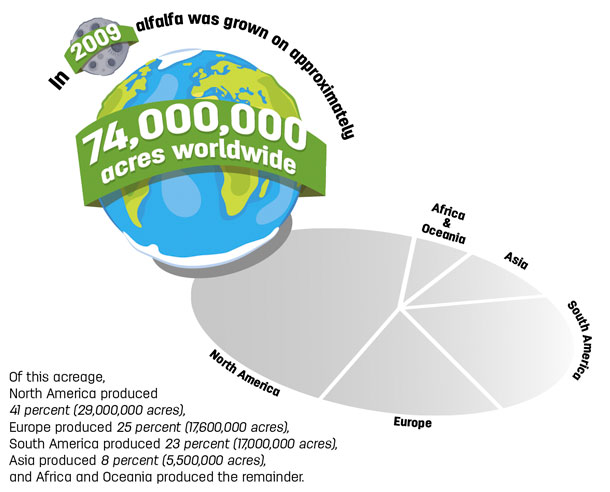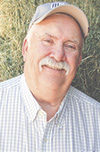Since its early origins in south-central Asia, alfalfa has spread around the globe and is utilized as a top-quality forage for livestock. The feeding value of the crop has made it the most cultivated forage legume in the world. Despite this distinction, there has always been the desire by alfalfa workers to improve alfalfa’s performance to an even higher level.
Much effort has gone into refining management practices to maximize yield and long-term performance as well as enhancing existing desirable traits and genetically adding new novel traits.
 In the last 50 years, alfalfa workers from around the world have made huge strides in improving alfalfa as a crop. Their success can be seen in the sheer number of acres currently grown around the world. In 2006, worldwide alfalfa production was around 436 million tons.
In the last 50 years, alfalfa workers from around the world have made huge strides in improving alfalfa as a crop. Their success can be seen in the sheer number of acres currently grown around the world. In 2006, worldwide alfalfa production was around 436 million tons.
In 2009, alfalfa was grown on approximately 74,000,000 acres worldwide. Of this acreage, North America produced 41 percent (29,000,000 acres), Europe produced 25 percent (17,600,000 acres), South America produced 23 percent (17,000,000 acres), Asia produced 8 percent (5,500,000 acres), and Africa and Oceania produced the remainder. The U.S. was the largest alfalfa producer in the world by area in 2009 with 22,000,000 acres, but considerable production area is found in Argentina with 17,000,000 acres, Canada with 4,900,000 acres, Russia with 4,400,000 acres, Italy with 3,200,000 acres and China with 3,200,000 acres.
Several years ago, the idea of a world alfalfa conference was proposed as a means of taking advantage of all the different approaches of improving alfalfa by providing a forum for the free exchange of ideas between alfalfa workers from around the world. The first such World Alfalfa Conference was held in 2015 in Benghu, China, and was well-attended, with over 800 attendees. With the success of the first conference, a second one was planned for 2018, and Argentina was selected as the location.
The organizers of the Second World Alfalfa Conference listed the official objectives of the conference were to:
- Promote an updated scientific exchange regarding the cultivation of alfalfa
- Promote discussions on the most important aspects affecting cultivation of alfalfa in the world
- Facilitate commercial exchange of alfalfa products between countries
- Contribute to a better understanding by the general public about the importance of alfalfa on a global level
- Promote international cooperation for crop research
- Publicize production of alfalfa in Argentina
With these objectives in mind, the Second World Alfalfa Conference was held this past November. There were over 500 registered attendees representing 23 countries: Argentina (309), France (38), China (37), U.S. (32), Spain (31), Germany (14), Chile (12), Canada (10), Italy (7), Russia (5), Belgium (4), Pakistan (3), Brazil (3), Australia (3), Uruguay (3), Netherlands (3), Mexico (3), Bolivia (2), Colombia (2), Kazakhstan (2), New Zealand (2), Portugal (2) and Serbia (2).
The Second World Alfalfa Conference was a three-day event which included 43 speakers representing 10 countries (Argentina, Australia, Brazil, Canada, China, France, Italy, Netherlands and the U.S.). The overall program included a wide range of topics divided into eight sessions:
- World alfalfa production and demand
- Increasing water use efficiency in alfalfa production
- Abiotic stress (drought, salinity and cold) breeding and field management
- Biotic stresses: insects, diseases and weeds
- Genetically engineered alfalfas
- Breeding for alfalfa quality
- Alfalfa processing, new uses, new areas and export demand
- Alfalfa-based production systems to meet economic and environmental challenges
In addition to the oral presentations, there was an excellent poster session (46) and a trade show. On the last day of the conference, there was a bus field tour, which included the public National Institute of Agricultural Technology (INTA) alfalfa research trials and a tour of local hay and pellet operations.
The Argentine hosts were also very hospitable, providing a city historical and cultural tour. Entertainment was also provided, highlighting Argentine music and dance performances in which the audience could fully embrace local culture by viewing or participating in the dances, including the tango – a very fun addition to the program.
Conference highlights
One notable highlight of the meeting was a discussion of new gene-editing technologies like clustered regularly interspaced short palindromic repeats (CRISPR) that will enable alfalfa breeders to develop traits that were, in the past, only possible thru genetically modified organism (GMO) breeding. The exciting thing about this technology is that recently, U.S. regulators ruled this new technology will not be classified as GMO. Therefore, varietal development will be substantially cheaper without the regulatory requirements currently imposed on GMO varieties.
Numerous presentations also addressed the problem of climate change. Several researchers had alfalfa breeding projects focusing on traits such as drought, salinity, heat and stress tolerance – traits that will make alfalfa more adapted to challenging growing conditions caused by changing climates.
As an attendee of the Second World Alfalfa Conference, I would like to congratulate Daniel Horacio Basigalup, the organizing committee and INTA for a job well done. The diversity of how alfalfa workers from around the world approach improving alfalfa can help us overcome our paradigms. This exchange of ideas can only lead to greater creativity and ultimately more advances in alfalfa improvement in the future.
With the success of the first two world alfalfa conferences, a third is now being planned. Preliminary thinking is that it will be held in 2020 or 2021 in the U.S., possibly California.
For more detailed information on the recent meeting, do a web search for “proceedings of the second world alfalfa congress.” ![]()
INFOGRAPHIC: Infographic by Corey Lewis.

-
Don Miller
- Director of Product Development
- Alforex Seeds
- Email Don Miller










